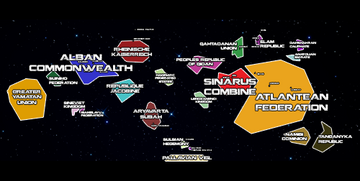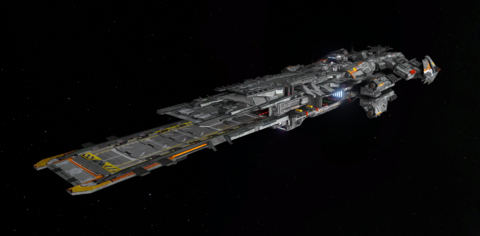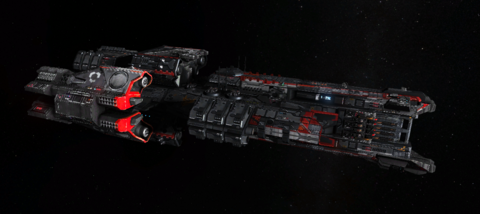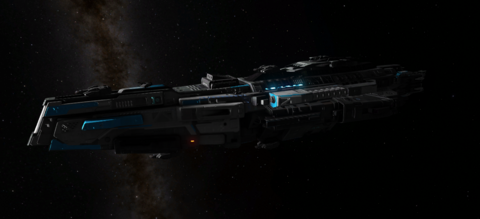Solaris (TC)
| The following information refers to the Solaris universe and is therefore not canon for the FreeSpace continuity. |
|---|
Solaris is a total conversion set in an original universe using the FreeSpace Open engine.
Contents
General Information
Solaris is set in an original universe using the FreeSpace Open engine to create a fast-paced, challenging and engaging space combat game.
This is combat in the FSO engine taken to another level. Face down brutal and dynamic AI enemies who weave and dodge incoming fire and have the same goals as you, the player: Stay alive and bring the other guy down first. Lead assaults against heavily armoured capital ships armed with relentless point defense cannons and powerful anti-ship missiles.
Use the right tools for the right job. Utilise various craft at your disposal - each one specialised for different roles. Fighters are the hunters of enemy strike craft, agile and deadly. Interceptors cannot be beaten for raw speed and have the firepower to back up their boast. Strikers are well armoured, armed with heavy cannons for strikes against capital ship subsystems.
Solaris embraces the concept of player movement equals player power. You are piloting an agile war machine with the ability to drift and strafe around incoming fire and obstacles. Use every dimension to your advantage, but beware: your enemies have just as much mobility as you do.
Released Campaigns
Background
The 23rd century should have seen the start of a new Golden Age in humanity's history, but instead was witness to a cataclysmic series of events that shook humankind to its core.
Humanity did not launch itself to the stars unified. The web of international rivalries, alliances and intrigues prevalent throughout human history accompanied the first colonisation efforts out of Earth's orbit and took on new context through the Orion Arm. To the stars humanity brought art, technology, commerce...and war.
The Great War of the 2230's was the climax of Earth's last efforts to keep the colonies under its rule, set against increasingly powerful nationalistic independence movements among the colonies. The war forged the national identities of fledgling nations while past empires died. The remnants of the Old World were swept away in nuclear fire.
With the end of the Great War a new international order was born. Humanity had been freed from the fetters of its history, and could finally set its sights out towards the stars.
Factions and Organizations
Great Powers
The Miranda Accord of 2236 was signed into effect amongst the ashes of the Great War. The war was remarkable in the excesses of the tactics and weapons used, harkening back to the unrestrained industrial warfare of centuries ago. Unrestricted nuclear orbital bombardment had left several planets ecologically devastated, including Earth. By the time of ceasefire, billions of souls had perished. Humanity would not survive another such war.
A conference attended by representatives of every sovereign star nation set into motion a solemn, binding vow - never again will such destruction visit humanity's homes among the stars.
In addition to finalising the terms of armistice, a major tenet of the treaty was drafted to prevent a repeat of this tragedy by restricting the storage and deployment of spaceborne nuclear weapons to capital ships. Further treaty restrictions to nuclear proliferation limited capital ships to the three recognised Great Powers: the Atlantean Federation, Sinarus Combine and Alban Commonwealth. If any nation violated these restrictions, an automatic declaration of war by the three Great Powers would be enacted to enforce the treaty.
Atlantean Federation
"Liberty. Independence. Justice."
The Alantean Federation is the pre-eminent military and economic power in the galaxy. Federation borders make up a vast area of territory in the Orion Arm almost 500 light years across, and encompasses dozens of multi-system subnations under the umbrella of a mutual defense pact. The Federation is by far the most heterogenous of the Terran Great Powers, which it champions as its biggest strength. However, this heterogeneity makes for an administrative nightmare, and the Federation strains under the tension of balancing member systems economic and political autonomy with the need for a centralised government to efficiently manage an increasingly hungry military budget.
The Federation is a federal republic and a representative democracy. Sovereignity is shared between the national and subnational levels of government, with the subnational government representing the various member nations that make up the Federation. Military spending and procurement is traditionally under the purview of the National Fleet Department but there have been increasing calls from subnational members for more financial autonomy, which includes military funding.
Federation naval doctrine begins and ends with working around the difficulties of covering a vast area of space. The Federation Navy is numerous, with a focus on maximising power projection and strategic reach of its task groups. Carrier strike groups are thus highly represented in the Federation Navy, with a fleet doctrine based around utilising numerous strikecraft as the mainstay of power projection. Supporting cruisers and other escorts are competent enough in combat with multiple small-calibre autocannons but are not designed to provide the primary punch. As a result, the Federation makes limited use of anti-ship missiles in its direct combat units, opting instead to install them on carriers and heavy bombers.
The Federation Navy is the largest of the Great Powers by numbers and tonnage, and is the primary tool for advancing national interests outside of the Federation's territory. The Navy operates a National Service model with those undertaking compulsory military service primarily assigned to support or logistics duties. Combat elements of the fleet are made up by regular servicemen and volunteers, with occasional representatives from other navies rotating through as part of an exchange program.
Sinarus Combine
"One people. One future."
The successor state of the Sol Combine is a shadow of its progenitor. Rising from the ashes of Earth's devastation, the leaders of the once-monolithic administrative and political core of Humanity collectively dusted themselves off and set about rebuilding anew. The economic fortunes of the Old World were left in ruins and significant challenges were faced by it's inheritors - densely populated systems previously dependant on Earth's infrastructure needed to be supplied, with resource-rich systems in the peripheray ceded to the Federation in the aftermath of the Great War.
What the Combine did have was population - a population made up of skilled, driven workers. The ruling government mobilised entire swatches of this population into rebuilding the industrial infrastructure. Investment from resource-rich nations was encouraged and economic output strengthened in the years to come. Combine leaders had to be ruthlessly efficient and utterly dedicated - there was very little room for error. Political dissent was relentlessly pursued and quashed, and power was concentrated at the upper echelons of the single-party government. Effective propaganda dissemination by the government ensured the nation's citizens knew this was a necessary sacrifice to ensure a future for generations to come.
As the economy recovered, the Sinarus Combine star fleet benefited from an extensive modernisation program. Heavily-armed warships are designed with less specialised roles than Federation equivalents with an emphasis on flexibility of movement and independent operations. The Combine Navy emphasises an "Alpha Strike" battle doctrine, utilising shock jump attacks with large-calibre weapons and heavy missiles. Combine battlecruisers with their balance of mobility and firepower have developed a fearsome reputation in the galaxy after successful demonstrations of these attacks.
The Combine extensively utilises heavy anti-ship missiles in its fleet units as well as batteries of large-calibre mass drivers. Rather than concentrate fighters and other strike craft in large carriers, Combine battle squadrons are often supplemented by numerous small support carriers for defensive purposes. These support carriers are often produced in substantial numbers: the Khopesh aviation frigates are by far most widely produced warship in the galaxy.
Alban Commonwealth
"For Crown and Country."
In the egalitarian political landscape of the 23rd century, a monarch as the head of state of a Great Power seems almost fanciful. Despite this, the years following the Great War have seen the Alban Commonwealth become the standard bearer for tolerance, social justice and non-partisanship in an increasingly hostile galaxy. The Alban Commonwealth is a constitutional monarchy ruled by the youthful Edward Wynson, a perspicacious and well-loved sovereign. Rumours circulate regarding House Wynson's ability to read and influence people, a trait shared by each generation of Wynson monarchs. This ability has taken on an almost mystical status from various embellishments over time, and the origin of King Edward's talent is kept a closely guarded national secret.
Fortune and foresight secured Commonwealth power. The capital system of Alba is the nexus of a densely populated hyperspace network, with extensive trading lanes established rapidly after the system was colonised. The Commonwealth's economy almost exclusively relies on trade, with Alban corporations maintaining some of the largest merchant navies in the galaxy.
During the final stages of the Great War, the Commonwealth took advantage of a unique opportunity to offer its services at mediation. In a diplomatic triumph, the Commonwealth arbitrated terms that satisfied both the Federation's territorial demands and the Combine's need to save face to its citizens. In 2236, the Alban Commonwealth chaired a conference attended by representatives from every independent star nation to draft the Miranda Accord. The prestige secured the recognition of the Commonwealth as a Great Power. Though not the military or industrial equal of the Federation or Combine, the Commonwealth still commands substantial economic and cultural power.
Commonwealth military strengths lie in research and development, personnel training and naval intelligence. His Majesty's Navy is the smallest of the three Great Powers but emphasis on these strengths goes some way to offset the disadvantage in tonnage. Commonwealth military doctrine revolves around numerous cruiser patrols safeguarding the extensive trade lanes - the source of the nation's wealth. With the added clout of being a Great Power came increasing calls for naval funding of capital ship construction and increased power projection. However, financing the significant operating expenses of the new Regent-class dreadnoughts remains a point of contention in the Alban parliament.
Middle Powers
Greater Yamatan Union
Republique Jacobine
Non-State Actors
Children of Renewal
Malika People's Militia
Campaign Walkthrough
TBFIL
Ships and Weapons Databases
Related Links
Solaris forum board | Hard-Light Productions
#solaris subchannel | Discord







